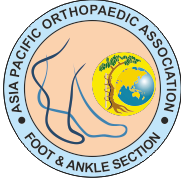Virtual Fellowship 2025
Complexities and treatment
Clawing
Table of contents
1. Complexity in Toe Deformity Management (Hammer, Claw, Cross-over Toe) [edit]
2. Complexity in Freiberg's Infraction Management [edit]
2.1. 1. Progressive Joint Damage (Smillie Staging)
The management of Hammer toe, Claw toe, Cross-over toe deformities, and Freiberg's infraction presents significant complexity due to the multifactorial etiologies, the progression from flexible to rigid deformities, the need for precise biomechanical correction, and the frequent coexistence of multiple pathologies.
Complexity in Toe Deformity Management (Hammer, Claw, Cross-over Toe) [edit]
The primary complexity in treating hammer, claw, and cross-over toe deformities lies in addressing the underlying cause and the severity of the joint contractures, which dictates the complexity of the required procedure.
1. Diagnosis and Staging
Flexible vs. Rigid Deformity: The management path depends heavily on whether the deformity is flexible (correctable by hand) or rigid (fixed contracture). Flexible deformities can often be managed with non-operative methods, whereas rigid ones typically require surgery involving bony procedures (osteotomies, arthrodesis).
Underlying Etiology: These deformities are often symptoms of a larger issue, such as neuromuscular disease (leading to claw toes, especially if multiple toes are affected), rheumatoid arthritis, or simple long-term ill-fitting footwear. Treating the toe in isolation without addressing the systemic or biomechanical cause (e.g., a long metatarsal) can lead to recurrence.
2. Surgical Challenges
Procedure Selection: Choosing the correct procedure is complex. Options range from simple soft tissue releases (tenotomies, capsulotomies) for flexible deformities to more extensive bony corrections (proximal interphalangeal joint arthroplasty/arthrodesis, metatarsal osteotomies, or plantar plate repair for cross-over toe) for rigid deformities and metatarsophalangeal (MTP) joint instability.
Achieving Alignment and Function: The goal is not just a straight toe, but one that is pain-free, functional, and maintains proper ground purchase. In cross-over toe, this involves complex reconstruction of the plantar plate and often an accompanying metatarsal shortening osteotomy (like a Weil osteotomy) to decompress the MTP joint, which carries a risk of a "floating toe" complication.
Complications: Common surgical complications include:
Recurrence of the deformity.
Stiffness or limited range of motion.
Inadequate correction (under- or overcorrection).
Transfer metatarsalgia, where pain shifts to an adjacent metatarsal head due to altered weight distribution.
Complexity in Freiberg's Infraction Management [edit]
Freiberg's Infraction is an osteochondrosis (avascular necrosis) of a metatarsal head, most commonly the second, leading to collapse and joint degeneration. The complexity here revolves around the late presentation, the progressive nature of the joint damage, and the difficulty in restoring a smooth, pain-free joint surface.
1. Progressive Joint Damage (Smillie Staging)
Staging Dependence: Treatment is heavily dictated by the disease stage (Smillie Classification, from Stage I-V). Early stages (I-II) may respond to non-operative treatment, but advanced stages (III-V), which involve collapse, fragmentation, and severe arthritis, mandate surgical intervention.
Lack of Consensus: For advanced stages, there is no single optimal surgical procedure. The surgeon must choose from a variety of joint-sparing or joint-destructive options, including:
Debridement and Cheilectomy: Removing bone spurs and damaged cartilage.
Dorsal Closing-Wedge Osteotomy (Gauthier/Helal): Aims to rotate healthy plantar cartilage into the weight-bearing position and shorten the metatarsal to decompress the joint.
Joint Destructive Procedures (e.g., Arthroplasty): Resection or interposition arthroplasty for end-stage arthritis.
2. Surgical Goals and Limitations
Pain Relief vs. Function: While surgery often provides pain relief, full restoration of motion and function is not always achievable, and patients must be counseled on the realistic potential for residual stiffness.
Metatarsal Shortening and Transfer Metatarsalgia: Procedures that involve shortening the metatarsal head (like an osteotomy) are often necessary but can increase the risk of transfer metatarsalgia to an adjacent metatarsal head, which is a major long-term challenge.
Compounding Complexity: Coexisting Conditions [edit]
The management becomes even more complex when toe deformities and Freiberg's infraction coexist, as they often do, or when other concurrent foot pathologies are present.
Freiberg's and Deformity: Advanced Freiberg's infraction of the second metatarsal head frequently leads to MTP joint instability and an associated claw toe or cross-over toe deformity. Correcting the toe alignment and function (the deformity) is impossible without also addressing the underlying damaged metatarsal head (Freiberg's).
Interdependent Procedures: Surgical planning must be comprehensive, often requiring multiple, simultaneous procedures (e.g., Weil osteotomy for Freiberg's coupled with a plantar plate repair and PIP joint arthrodesis for the associated cross-over hammer toe). Correcting one component improperly can undermine the success of the entire operation.
Hallux Valgus (Bunion): Coexistence with a bunion (Hallux Valgus) adds complexity because the bunion pathology must often be addressed first to create space and improve the biomechanical environment for the lesser toe correction.
In summary, the complexity stems from accurately diagnosing the flexibility and stage of the deformity, choosing the multi-faceted surgical strategy to address both soft tissue and bone, and effectively managing patient expectations regarding pain, function, and the high potential for residual stiffness or other postoperative complications like transfer metatarsalgia.

